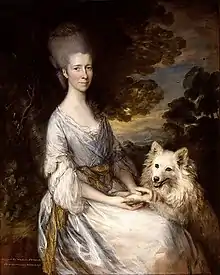| Whichcote baronets | |
|---|---|
.svg.png.webp) Escutcheon of the Whichcote baronets of the Inner Temple | |
| Creation date | 1660[1] |
| Status | extinct |
| Extinction date | 1949 |
| Motto | Juste et droit, Just and right[1] |
The Whichcote Baronetcy, of the Inner Temple in the City of London, was a title in the Baronetage of England. It was created on 2 April 1660 to reward Jeremy Whichcote for his services to the exiled King Charles II.[2] Whichcote, previously Solicitor-General to Prince Rupert of the Rhine, bought the post of Warden of Fleet Prison and, during the Commonwealth, was able to shelter the king's friends and agents in this way.[3]
The third Baronet sat as Member of Parliament for Cambridgeshire. The seventh Baronet was High Sheriff of Lincolnshire in 1837. The ninth Baronet was High Sheriff of Lincolnshire in 1900. The title became extinct on the death of the tenth Baronet in 1949.
Benjamin Whichcote was the elder brother of the first Baronet.
Whichcote baronets, of the Inner Temple (1660)
- Sir Jeremy Whichcote, 1st Baronet (c. 1614–1677)[4]
- Sir Paul Whichcote, 2nd Baronet (1643–1721)[5]
- Sir Francis Whichcote, 3rd Baronet (c. 1692–1775)[6][7]
- Sir Christopher Whichcote, 4th Baronet (1738–1786)[8]

Jane, Lady Whichcote, 1775 portrait by Thomas Gainsborough
- Sir Thomas Whichcote, 5th Baronet (1763–1828)[1]
- Sir Thomas Whichcote, 6th Baronet (1787–1829)[1]
- Sir Thomas Whichcote, 7th Baronet (1813–1892)[1]
- Sir George Whichcote, 8th Baronet (1817–1893)[1][9]
- Sir George Whichcote, 9th Baronet (1870–1946)[10][9]
- Sir Hugh Christopher Whichcote, 10th Baronet (1874–1949)[11]
References
- 1 2 3 4 5 6 Foster, Joseph (1881). The baronetage and knightage. Nichols and Sons. p. 652.
- ↑ "Complete baronetage Volume 3". W. Pollard & co. Retrieved 20 October 2018.
- ↑ Hendon & District Archaeological Society Hendon House
- ↑ Johnson, Richard (1771). The Baronetage of England:: Containing a Genealogical and Historical Account of All the English Baronets Now Existing: with Their Descents, Marriages, and Memorable Actions Both in War and Peace. Collected from Authentic Manuscripts, Records, Old Wills, Our Best Historians, and Other Authorities. Illustrated with Their Coats of Arms, Engraven on Copper-plates. Also, a List of All the Baronets, who Have Been Advanced to that Dignity, from the First Institution Thereof. To which is Added, An Account of Such Nova-Scotia Baronets as are of English Families; and a Dictionary of Heraldry, Explaining Such Terms as are Commonly Used in English Armory. G. Woodfall, J. Fuller, E. Johnson, Hawes, Clarke and Collins, W. Johnston, [and 11 others in London]. p. 4.
- ↑ "Paul Whitchcot (WHTT662P)". A Cambridge Alumni Database. University of Cambridge.
- ↑ "Whichcote, Francis (c.1692-1775), of Quy Hall, Cambs. and Aswarby, Lincs., History of Parliament Online". www.historyofparliamentonline.org.
- ↑ "Francis Whichcote (WHCT708F)". A Cambridge Alumni Database. University of Cambridge.
- ↑ "Whichcote, Christopher (WHCT756C)". A Cambridge Alumni Database. University of Cambridge.
- 1 2 "Whichcote, George (WHCT892G)". A Cambridge Alumni Database. University of Cambridge.
- ↑ "Whichcote, Sir George". Who's Who. A & C Black. Retrieved 16 October 2021. (Subscription or UK public library membership required.)
- ↑ "Whichcote, Sir Hugh Christopher". Who's Who. A & C Black. Retrieved 16 October 2021. (Subscription or UK public library membership required.)
This article is issued from Wikipedia. The text is licensed under Creative Commons - Attribution - Sharealike. Additional terms may apply for the media files.